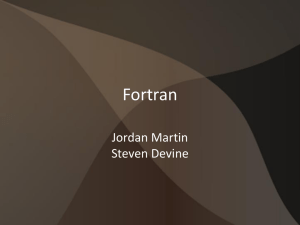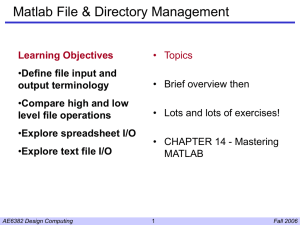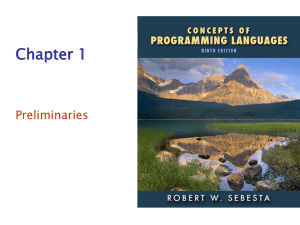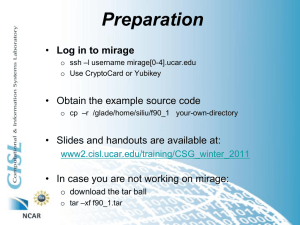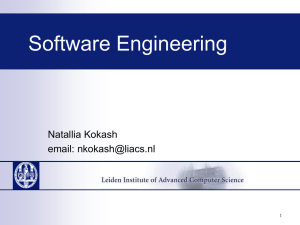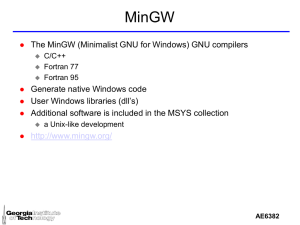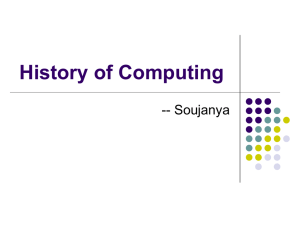Intro to Fortran
advertisement
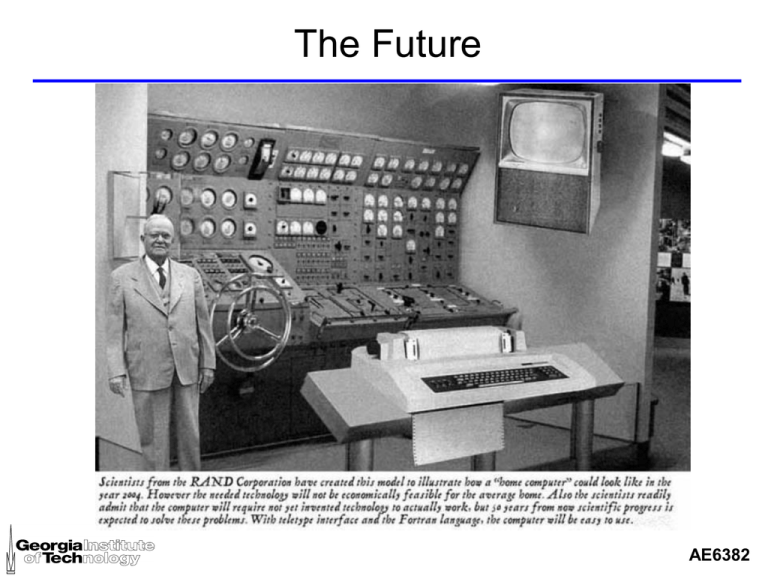
The Future
AE6382
Introduction to FORTRAN
OBJECTIVES
History and purpose of FORTRAN
FORTRAN essentials
Program structure
Data types and specification statements
Essential program control
FORTRAN I/O
subfunctions and subroutines
Extensions for Fortran 95
Pitfalls and common coding problems
Sample problems
AE6382
FORTRAN History
One of the oldest computer languages
Version history
created by John Backus and released in 1957
designed for scientific and engineering computations
FORTRAN 1957
FORTRAN II
FORTRAN IV
FORTRAN 66 (released as ANSI standard in 1966)
FORTRAN 77 (ANSI standard in 1977)
FORTRAN 90 (ANSI standard in 1990)
FORTRAN 95 (ANSI standard version)
FORTRAN 2003 (ANSI standard version)
Many different “dialects” produced by computer vendors (Digital
VAX Fortran, now Intel Fortran)
Large majority of existing engineering software is coded in
FORTRAN (various versions)
AE6382
Statement Format
FORTRAN before 90 requires a fixed format
PROGRAM MAIN
C COMMENTS ARE ALLOWED IF A “C” IS PLACED IN COLUMN #1
DIMENSION X(10)
READ(5,*) (X(I),I=1,10)
WRITE(6,1000) X
1000 FORMAT(1X,’THIS IS A VERY LONG LINE OF TEXT TO SHOW HOW TO CONTINUE ’
*
1-5 6
Label
‘THE STATEMENT TO A SECOND LINE’,/,10F12.4)
7-72 Statements
73-80
Optional
Line #s
Any character: continuation line
Based on the punch card in use when Fortran was
created
AE6382
Statement Format
FORTRAN fixed format
“C” in column 1 indicates that line is a comment
columns 1-5 are reserved for statement labels
–
–
column 6 is the continuation flag
–
–
statement labels are not required unless the statement is the target
of a goto
labels are numeric values only
any character in column 6, other than space or “0”, indicates that
this line is a continuation of the previous line
there is usually a limit of 19 on the number of continuations
columns 7-72 are contain Fortran statements
columns 73-80 is for sequence information
–
only of any use when using punch cards
AE6382
Statement Format
IBM punch card
AE6382
Building a FORTRAN Program
FORTRAN is a complied language (like C) so the source
code (what you write) must be converted into machine
code before it can be executed (e.g. Make command)
Link with
Libraries
FORTRAN
Compiler
FORTRAN
Program
Source Code
Make Changes
in Source Code
Object Code
Libraries
Test & Debug
Program
Executable
File
Executable
Code
Execute
Program
AE6382
Structure of a Fortran Program
Fortran is a compiled language
all memory is allocated statically at compile time
–
–
there is no official recursion before Fortran 90
–
–
there is no standard method for allocating additional memory in a
Fortran program before Fortran 90
memory is allocated in a predictable manner, a fact which can be
used by the programmer to his advantage or distress
some vendor implementations had recursive capabilities
static memory allocation is at odds with the use of a stack which is
needed for recursion
Fortran does not guarantee value of un-initialized memory
AE6382
Structure of a Fortran Program
Fortran consists of program units
program
function
subroutine
block data
The program unit contains the main code and the point
where execution starts
in Fortran 77 a program begins with the program statement
earlier versions of Fortran did not have a program statement
unless a vendor dialect provided one
the end statement terminates the program unit
AE6382
Fortran Program
The program unit contains the main code and the point
where execution starts
in Fortran 77 a program begins with the program statement
earlier versions of Fortran did not have a program statement
unless a vendor dialect provided one
the end statement terminates the program unit
–
–
marks end of statements that belong to program
during execution it will cause the program to halt
a program unit may contain internal sub-programs
–
–
internal functions
internal subroutines
AE6382
Fortran Subroutine
The subroutine unit contains Fortran code that can be
called from other Fortran code
a subroutine begins with a subroutine statement
contains a name for the subroutine
a list of formal arguments
subroutines may be internal or external
an internal subroutine is included in the code of program unit
and is only callable by the program
an external subroutine is created outside of a program unit and
is callable from everywhere
AE6382
Fortran Subroutine
SUBROUTINE MULT(A,B,C)
C = A * B
RETURN
END
CALL MULT(5.0,X,VALUE)
AE6382
Fortran Function
The function unit contains Fortran code that can be
called from other Fortran code
It differs from a subroutine in that it returns a value
a subroutine begins with a function statement
contains a name for the function
a list of formal arguments
specifies a return type
functions may be internal or external
an internal function is included in the code of program unit and is
only callable by the program
an external function is created outside of a program unit and is
callable from everywhere
AE6382
Fortran Function
REAL FUNCTION MULT(A,B)
MULT = A * B
RETURN
END
VALUE = MULT(5.0,X)
AE6382
Fortran Block Data
The Block Data program unit does not contain any
executable code
Used to initialize memory in common blocks
It is not “called” by any code in the program, it contains
instructions for the initializing memory when the program
is loaded into memory for running
AE6382
Fortran Block Data
BLOCK DATA
COMMON/MEM/A,B
DATA A,B/10.0,-3.14/
END
AE6382
Fortran Program Organization
Program units have a statement order
header (program, subroutine, function, block data)
declarations (variables and types)
data initialization (data statements)
executable statements (and format statements)
internal subprogram units
end statement
AE6382
Fortran Variable
Variables represent the memory of the program
Fortran variables
Up through 77, spaces in a Fortran program are ignored
Fortran IV numbers and letters, at least 6 characters
Fortran 77 numbers and letters and “_”, at least 16 characters
must start with a letter
IVALUE and I VAL UE are the same
using strange spacing, while acceptable, is bad practice
Fortran variables are typed
Fortran is case insensitive
ivar is the same as IVAR or IvAr
AE6382
Fortran Variable Typing
All Fortran variables are typed
INTEGER
REAL
DOUBLE PRECISION
COMPLEX
LOGICAL
CHARACTER (77+)
AE6382
Fortran Variable Typing
A feature of Fortran – implicit typing
when a variable appears that has not been declared previously it
is created (at compile time)
it is assigned a type based on the first character of the name
–
–
a typo can cause the creation of a new variable – not an error
Starting with 77 the implicit statement was added
A-H,O-Z is type REAL
I-N is type INTEGER
allowed changing the first letter assignments
most 77 compilers include the implicit none statement that
requires that all variables be explicitly typed – prevents the typo
problem
It is good practice to use implicit none
AE6382
Fortran Variable Typing
Change implicit typing so that A becomes an INTEGER type
PROGRAM TEST
IMPLICIT INTEGER (A)
Disable implicit typing altogether
PROGRAM TEST
IMPLICIT NONE
AE6382
Fortran Variable Typing
In Fortran any variable can be explicitly typed
In the declarations section enter a type identifier followed
by a list of variable names
INTEGER A,VALUE,ISTART
REAL INITIAL_VALUE
The first letter implicit typing is over-ridden when explicit
typing is used
A common Fortran error when using implicit typing is to
use a variable such as INITIAL_VALUE as if it contained
a real (floating point) value
AE6382
Fortran Variable Typing
The types presented earlier are the default types
The range of both INTEGER and REAL are dependent
on the computer architecture
one computer may have a 32 bit integer while another may use
16 bit as its default
An attempt to deal with this lead to types such as
REAL*8, INTEGER*4
the number after the * indicates the number of bytes used
most computers have 8 bit bytes
not every architecture will have every combination
not a practical problem in an Intel world
but knowledge of the architecture of the system where a legacy
Fortran program was developed is needed to convert to Intel
AE6382
Fortran Variable Typing
Fortran 90+ uses a different method to deal with number
ranges that is architecture independent
AE6382
Fortran Variable Typing
The CHARACTER type was introduced in 77
The * notation is used to specify the maximum number
of characters the variable can hold
CHARACTER*20 TITLE
Before 77 the Hollerith notation was used
common in older Fortran code, even in some 77 code
normally placed characters into INTEGER arrays
required knowledge of byte length of the variable
portability problem
INTEGER*4 TITLE(5)
DATA TITLE/4Habcd,4Hefgh,…/
AE6382
Fortran Arrays
The array is the only data structure supported in 77 and
before
An array is a linear allocation of memory
An array can contain up to 7 dimensions
Arrays are indexed starting a 1
INTEGER A
DIMENSION A(10
INTEGER B
DIMENSION B(10,10)
REAL C(10,10,10)
AE6382
Fortran Arrays
Fortran 77 introduced the ability to specify a lower bound
for an array dimension
INTEGER B
DIMENSION B(0:10,0:10)
During execution of a Fortran program there is normally
no check made on array index bounds
there may be a compiler option to enable these checks
some bound checking code only checks the equivalent linear
index not each individual index
AE6382
Fortran Arrays
Fortran character (77)
CHARACTER*10 TITLE(4)
AE6382
Fortran Variables and Subroutines
All arguments to a Fortran subroutine are passed by
reference
the subroutine receives the address of the variable
any changes made by the subroutine are seen by the caller
most other languages pass by value (the subroutine receives a
copy)
passing an array as an argument with just the name will pass the
address of the first element
On entry to a subroutine its local variables are not
guaranteed to have any known value
the save statement introduced in 77 will ensure that a variable
will have on entry the value that it had on its last exit from the
subroutine
AE6382
Fortran Common Blocks
Normally variables in a Fortran program are local to the
unit in which they are declared
variables may be made known to subroutines using the
arguments
variables may be created in a common block
Common blocks are shared memory
each program unit that declares the common block has access
to it
AE6382
Fortran Common Blocks
Two types of common
blank common – unnamed
named common
Most systems do not allow blank common to be
initialized
Blank common can sometimes be used to allocate
unused memory (depends on OS)
COMMON A,B(10),C
COMMON/SET1/A,B(50,5),C
AE6382
Fortran Common Blocks
Problems
each program unit that declares access to a common block
defines it’s own view
–
–
type of each variable in the block
size of each array in the block
when views between units differ there can be problems – some
linkers will warn of size differences
PROGRAM TEST
COMMON/A/A,B(10),C
END
SUBROUTINE DOIT
COMMON/A/I,J(5),K(20)
END
AE6382
Fortran Equivalence
The EQUIVALENCE statement is used to alias a memory
location
Usually will include a type change
Also used to provide aliases for elements of an array
INTEGER A(100)
EQUIVALENCE (INCREMENT,A(4))
COMMON A(10000)
INTEGER IA(1)
EQUIVALENCE (IA(1),A(1))
Takes advantage of no index checking
AE6382
Fortran Parameter
The PARAMETER statement is used to define constants
PARAMETER (MAX=20)
A parameter can be used wherever a variable is
expected – but cannot be overwritten
Can be used in declarations
PARAMETER (MAX=1000)
INTEGER A(MAX)
AE6382
Fortran Literals
Literals are constants that appear in a Fortran program
Number
Other
integers - 1, -34
real - 1.0, 4.3E10, 5.1D-5
complex – (5.2,.8)
logical - .true., .false.
character – ‘title line’
Obsolete but still lurking in code
Hollerith – 4Habcd, 8Habcdef
AE6382
Fortran Literals
INTEGER A
A = 34
REAL A(20)
A(1) = 31.4159E-1
ITERM = -10.3
COMPLEX Z
Z = (10,-10.5)
REAL_PART = REAL(Z)
AIMAG_PART = AIMAG(Z)
Z = CMPLX(REAL_PART * 2,AIMAG_PART)
AE6382
Fortran Expressions
Expressions are the heart of Fortran (Formula
Translator)
There are two types of expressions
numeric
–
–
2 * 3.14159 * RADIUS**2
SIN(PI)
logical
–
–
IBOOL = .TRUE.
I .EQ. 10 .AND. ISTOP
• note: LOGICAL ISTOP
AE6382
Fortran Numerical Operators
The numerical operators
**
(exponentiation)
*/
unary + binary + -
Parentheses are used to alter the order of evaluation
For binary operators, if the types do not match an implicit
conversion is performed to the most general type
–
–
integer -> real -> double precision
anything -> complex
AE6382
Fortran Numerical Operators
WARNING: division of an integer by an integer will
produce a truncated result
–
–
5/2
FLOAT(5)/2
=>
=>
2 not 2.5
2.5
The type-conversion intrinsic functions can be used to
get the desired results
AE6382
Intrinsic Functions
Fortran includes an extensive set of built-in functions
Fortran 66 has different names for these functions
depending on the return type and argument type
Fortran 77 introduced generic names for intrinsic
functions
AE6382
Type Conversion
The intrinsic functions have two forms
–
–
Conversion to integer
–
–
–
–
generic
available only in 77 and above
argument specific
INT(any)
the generic version
INT(real)
IFIX(real)
IDINT(double)
Conversion to real
–
–
–
–
REAL(any)
the generic version
FLOAT(integer)
REAL(integer)
SNGL(double)
AE6382
Type Conversion
Conversion to double
–
COMPLX(any) the generic version
Character to integer (77+ only)
–
the generic version
Conversion to complex
–
DBLE(any)
ICHAR(character)
Integer to character (77+ only)
–
CHAR(integer)
AE6382
Truncation
To integer part, return as real or double
–
–
–
the generic version
To nearest integer, return as real or double
–
–
–
AINT(real or double)
AINT(real)
DINT(double)
ANINT(real or double)
ANINT(real)
DNINT(double)
the generic version
To nearest integer, return as integer
–
–
–
NINT(real or double)
NINT(real)
IDNINT(double)
the generic version
AE6382
Math Functions
sine and cosine (radians)
–
–
–
–
the generic version
exponential
–
–
–
–
SIN(real or double)
SIN(real)
DSIN(double)
CSIN(complex)
EXP(real or double)
EXP(real)
DEXP(double)
CEXP(complex)
the generic version
natural logarithm
–
–
–
–
LOG(real or double)
ALOG(real)
DLOG(double)
CLOG(complex)
the generic version
AE6382
Math Functions
tangent (radians)
–
–
–
the generic version
square root
–
–
–
–
TAN(real or double)
TAN(real)
DSIN(double)
SQRT(real or double)
SQRT(real)
DSQRT(double)
CSQRT(complex)
the generic version
hyperbolic sine
–
–
–
SINH(real or double)
SINH(real)
DSINH(double)
the generic version
AE6382
Math Functions
there are also similar functions for
arcsine, arccosine, arctangent (ASIN, ACOS, ATAN)
hyperbolic sine, cosine, tangent (SINH, COSH, TANH)
complex conjugate (CONJ)
base10 logarithms (LOG10)
AE6382
Fortran Statements
The executable statements in Fortran
assignment (=)
branching (GOTO)
comparison (IF)
looping (DO)
subroutine invocation (CALL)
AE6382
Fortran Assignment
The simple assignment statement stores the result of
computations into a variable
DIMENSION A(10,10)
…
A(I,10) = 2.0 * PI * R**2
INTEGER A
A = A + 1
AE6382
Fortran Branching
Fortran includes a GOTO statement
In modern languages this is considered very bad
its use was essential in Fortran 66 its predecessors
Fortran 77 introduced control statements that lessened the need
for the GOTO
IF (I .EQ. 0) GO TO 100
A = 4.0 * AINIT
GOTO 200
100 B = 52.0
…
200 C = B * A
AE6382
Fortran Branching
The Fortran GOTO always branched to a Fortran
statement that contained a label in columns 1-5
The labels varied from 1 to 99999
Variations of the go to statement are
Spaces are ignored in Fortran code before 90
assigned goto
computed goto
GOTO and GO TO are equivalent
Excessive use of the goto (required in 66 and before)
leads to difficult to understand code
AE6382
Fortran Branching
Assigned goto
ASSIGN 100 TO TARGET
…
GOTO TARGET
…
100 CONTINUE
AE6382
Fortran Branching
Computed goto
Operates much like a case or switch statement in other
languages
GOTO (100,200,300,400),IGO
…
100 CONTINUE
…
GOTO 500
200 CONTINUE
…
GOTO 500
…
500 CONTINUE
AE6382
Fortran Continue
The CONTINUE statement is a do-nothing statement and
is frequently used as a marker for labels
It is used most frequently with DO loops
AE6382
Fortran IF
The IF statement is used to perform logical decisions
The oldest form is the 3-way if (also called arithmetic if)
The logical if appeared in Fortran IV/66
The more modern if-then-else appeared in Fortran 77
AE6382
Fortran 3-way If
The 3-way if statement tested a numerical value against
zero
It branched to one of three labels depending on the
result
IF (RADIUS) 10,20,30
10 CONTINUE
…
GOTO 100
20 CONTINUE
…
GOTO 100
30 CONTINUE
…
IF (ABS(RADIUS-EPS)) 10,10,20
10 CONTINUE
…
GOTO 100
20 CONTINUE
…
GOTO 100
100 CONTINUE
GOTO 100
100 CONTINUE
AE6382
Fortran Logical If
The logical if statement performed a test using the
logical operators
.EQ., .NE., .LT., .LE., .GT., .GE.
.AND., .OR., .NOT.
If result is true then a single statement is executed
IF (ISTART .EQ. 50) GOTO 100
…
100 CONTINUE
IF (IMODE .EQ. 2) A = SQRT(CVALUE)
…
LOGICAL QUICK
QUICK = .TRUE.
IF (QUICK) STEP=0.5
IF (.NOT. QUICK) STEP = 0.01
AE6382
Fortran Logical If
LOGICAL QUICK
QUICK = .TRUE.
IF (QUICK) STEP=0.5
IF (.NOT. QUICK) STEP = 0.01
…
IF (QUICK .AND. (ABS(XVALUE – EPS) .LT. 0.005)) GOTO 1000
AE6382
Fortran Modern If
Fortran 77 introduced the modern if statement (so-called
structured programming)
The test operated the same as the logical if
Greatly reduced the need for using the goto statement
Includes
then clause
else clause
else if clause
AE6382
Fortran Modern If
This form eliminates the goto statements from the
previous example
LOGICAL QUICK
QUICK = .TRUE.
IF (QUICK) THEN
STEP=0.5
ELSE
STEP = 0.01
ENDIF
…
IF (QUICK .AND. (ABS(XVALUE – EPS) .LT. 0.005)) THEN
…
END IF
AE6382
Fortran Modern If
This form reduces the need for the computed goto
IF (MODE .EQ. 0) THEN
…
ELSE IF (MODE .EQ. 1) THEN
…
ELSEIF (MODE .EQ. 2) THEN
…
ELSE
…
END IF
AE6382
Fortran Looping
The DO statement is the mechanism for looping in
Fortran
The do loop is the only “official” looping mechanism in
Fortran through 77
DO 100 I=1,10,2
…
100 CONTINUE
Here I is the control variable
it is normally an integer but can be real
1 is the start value
10 is the end value
2 is the increment value
everything to the 100 label is part of the loop
AE6382
Fortran Looping
The labeled statement can be any statement not just
continue
Loop may be nested
nested loops can share the same label – very bad form
DO 100 I=1,10,2
DO 100 J=1,5,1
…
100 A(I,J) = VALUE
DO 200 I=1,10,2
DO 100 J=1,5,1
…
A(I,J) = VALUE
100 CONTINUE
200 CONTINUE
AE6382
Fortran Looping
Before Fortran 77 a do loop would always execute at
least once – despite the parameters
DO 100 I=10,1,2
…
100 CONTINUE
The increment may be negative, if not specified it is
assumed to be 1
AE6382
Fortran Looping
WARNING: Through Fortran 77 there is an extended do
loop
can jump out of loop to code outside the loop
that code can jump back into the loop
valid as long as code does not modify the control variable
no need to ever use it – use a subroutine instead
DO 100 I=1,100
DO 100 I=1,100
…
…
GOTO 1000
CALL XYZ
…
…
99 CONTINUE
…
100 CONTINUE
…
100 CONTINUE
…
1000 CONTINUE
…
GOTO 99
AE6382
Fortran Looping
Fortran 77 introduced a form of the do loop that does not
require labels
DO I=1,100
…
ENDDO
DO I=1,100
DO J=1,50
A(I,J) = I*J
END DO
ENDDO
The indented spacing shown is not required
AE6382
Fortran Looping
A variant of Fortran 77 known as MIL-STD 1753
introduced a new loop construct – the while loop
While not part of the Fortran standard it is available in
almost all Fortran 77 compilers
DO WHILE (I .LT. 1000)
…
ENDDO
This form is an infinite loop and would require an
additional test in the loop to exit
DO WHILE (.TRUE.)
…
END DO
AE6382
Fortran Looping
Finally, there is a form of the do loop called the implied
do loop
It is used on READ, WRITE, and DATA statements
READ(5,8000) (A(I),I=1,10)
WRITE(6,8000) ((A(I,J),I=1,10),J=1,10)
DATA ((IX(I,J),I=1,10),J=1,10)/1,2,3…/
AE6382
Fortran Subroutine Invocation
There are two methods by which a sub program can be
called in Fortran
use the CALL statement for subroutines
as part of a numerical expression for a function
CALL XX(A,B,C)
…
VALUE = 4.3 * ROOT(X)
…
SUBROUTINE XX(X,Y,Z)
REAL FUNCTION ROOT(A)
…
…
END
END
AE6382
Fortran Subroutine Invocation
The variables on the invocation are the actual arguments
The variables in the declaration are the formal
arguments
More about sub programs will be covered later
AE6382
Miscellaneous Statements
There are several other Fortran statements
RETURN will cause a sub program to return to the caller at that
point – the END statement contains an implied RETURN
a number on a RETURN statement indicates that an alternate
return be taken
STOP will cause a program to terminate immediately – a number
may be included to indicate where the stop occurred, STOP 2
PAUSE will cause the program to stop with a short message –
the message is the number on the statement, PAUSE 5
AE6382
Fortran I/O Statements
Fortran contains an extensive input/output capability
The relevant statements are
READ
WRITE
OPEN
CLOSE
INQUIRE
REWIND
BACKSPACE
ENDFILE
FORMAT
Fortran I/O is based on the concept of a unit number
5 is generally input – stdin on Unix
6 is usually output – stdout on Unix
other unit numbers can be created as needed
AE6382
Fortran I/O Statements
Management of unit numbers was not specified in any
system independent way before Fortran 77
older programs will just use a unit without any declaration – the
linkage to a file was performed by the OS
the following usage is common
PROGRAM MAIN(INPUT,OUTPUT,TAPE5=INPUT,TAPE6=OUTPUT)
this is non-standard and can only be used as a guide when
converting Fortran program to a modern OS (Linux, Unix, or
Windows)
AE6382
Fortran I/O Statements
There are two types of I/O in Fortran
There are two modes of operation
formatted
unformatted or binary
sequential
random
Formatted I/O uses a format statement to prepare the
data for output or interpret for input
Unformatted I/O does not use a format statement
the form of the data is generally system dependent
usually faster and is generally used to store intermediate results
AE6382
Fortran I/O Statements
Unformatted I/O does not use a format statement
WRITE(9) A,B,C,D,E
The reverse operation is
READ(9) A,B,C,D,E
AE6382
Fortran I/O Statements
The FORMAT statement is the heart of the Fortran
formatted I/O system
The format statement instructs the computer on the
details of both input and output
size of the field to use for the value
number of decimal places
The format is identified by a statement label
WRITE(6,9000) A,B,C,D,E
9000 FORMAT(1X,4F8.5,2x,E14.6,//)
A format can be used any number of times
The label number must not conflict with goto labels
AE6382
Fortran I/O Statements
The Fortran I/O statements have a common form with a
common set of parameters
stmt(UNIT=n,FMT=label,IOSTAT=int-variable,ERR=label,END=label) list
The UNIT and FMT keywords can be omitted, in which
case the unit and format are the first two parameters
stmt(n,label,IOSTAT=int-variable,ERR=label,END=label) list
The other parameters are all optional
The list is the list of variables or expressions to be
converted to or from
Fortran IV/66 only uses a unit number and a format
label, some implementations allow END
stmt(n,label) list
AE6382
Fortran I/O Statements
The UNIT keyword is used to specify the device on
which to perform the I/O
The FMT keyword is used to specify a format label that
will be used to control the I/O
the keyword may be omitted – the unit must be the first
parameter
the keyword may be omitted – the format label must be the
second parameter
an unformatted I/O operation does not use a format
a character string may be used instead (77 only)
The NML keyword is used to specify a namelist group
NML and FMT are mutually exclusive
AE6382
Fortran I/O Statements
The IOSTAT keyword is used to specify an integer variable that will,
upon completion, contain a value that indicates how the I/O
completed
The ERR keyword is used to specify a statement label that will be
jumped to if an error occurs
= 0 – there was no error or EOF condition, OK
> 0 – the value is the error that occurred, this is implementation
dependent
< 0 – and EOF, end of file, was encountered
of specified, IOSTAT will contain the error code
The END keyword is used to specify a statement label that will be
jumped to if an EOF condition exists
The END and ERR keywords are not required, the programmer can
just test the value of IOSTAT
If IOSTAT or the END/ERR keywords are not used the Fortran library
will invoke a standard error response – usually terminate the
program
AE6382
Fortran I/O Statements
READ(5,9000) A,B,C,D,E
9000 FORMAT(1X,4F8.5,2x,E14.6,//)
READ(UNIT=5,FMT=9000,ERR=100) A,B,C,D,E
…
C come here on end of file
100 CONTINUE
…
9000 FORMAT(1X,4F8.5,2x,E14.6,//)
READ(5,’(1X,4F8.5,2x,E14.6,//)’,IOSTAT=IERR) A,B,C,D,E
IF (IERR) 100, 200, 300
C 100 – EOF, 200 – OK, 300 – an error
AE6382
Fortran I/O List
The I/O list is the list of variables or expressions that are
to be processed by an I/O statement
Formatted I/O will perform conversions between internal
binary format and external character format
Unformatted I/O does not conversion
There are three forms of formatted I/O
the standard form
list directed
namelist directed
AE6382
Fortran Formatted I/O
The standard form
List directed, also called free format
requires the use of a format statement that is used to control the
conversion process
normally used for bulk input or output
performs the conversion based on the type of the next variable
in the I/O list
the format is specified as * or FMT=*
frequently used for user typed input or debugging statements
data separated by blanks or commas
Namelist directed
conversion is controlled by variable type
data is entered by name
AE6382
Fortran I/O Statements
READ(6,*) A,B,I
--- the input below
4.5 17 35
WRITE(6,*) ‘The value of a=‘,A
NAMELIST /CONTROL/ A,B,TITLE
INTEGER A
CHARACTER*80 TITLE
READ(5,NML=CONTROL)
--- the input below
&CONTROL
TITLE=‘A title line’
A=5
B=3.14
/
AE6382
Fortran I/O List
The I/O list part of the statement defines the variables to
be used
a READ statement must contain only variables
a WRITE statement can contain constants and expressions in
addition to variables
implied do-loops are permitted
if an array variable is included with any indexing supplied then
an implied do-loop is implied
–
iterates through the entire array, left-most indices varying most
rapidly
REAL A(5,5)
READ(5,*) A
--- same as
READ(5,*) ((A(I,J),I=1,5),J=1,5)
AE6382
FORMAT Statement
Very powerful and versatile but can be quite tedious to
master and may vary between dialects
Designed for use with line printers (not screens)
Only infrequently used for input unless data format is
clearly defined and consistently applied
General:
Syntax: label_no FORMAT(format-specifiers)
Specifies format to be used in READ or WRITE statement that
references this label_no.
format_specifiers are quite extensive and complex to master.
each format specifier is separated by a comma.
AE6382
Format Specifiers
X format code
I format code
Syntax: Iw
Specifies format for an integer using a field width of w spaces. If
integer value exceeds this space, output will consist of ****
F format code
Syntax: nX
Specifies n spaces to be included at this point
Syntax: Fw.d
Specifies format for a REAL number using a field width of w
spaces and printing d digits to the right of the decimal point.
A format code
Syntax: A or Aw
Specifies format for a CHARACTER using a field width equal to
the number of characters, or using exactly w spaces (padded
with blanks to the right if characters are less than w.
AE6382
Format Specifiers – cont’d
T format code
Literal format code
Syntax: Tn
Skip (tab) to column number n
Syntax: ‘quoted_string’
Print the quoted string in the output (not used in input)
L format code
Syntax: Lw
Print value of logical variable as T or F, right-justified in field of
width, w.
AE6382
Format Specifiers – cont’d
BN format code
Syntax: BN
Ignore embedded blanks in a numeric field
BZ format code
Syntax: BZ
Treat embedded blanks in a numeric field as zero
AE6382
Format Specifiers – cont’d
The BN and BZ codes are Fortran 77
Before Fortran 77 blanks were treated as zero
8000 FORMAT(BN,I10)
|----+----o----+----o----+----o----+----|
-1234
result: -1234
8000 FORMAT(BZ,I10)
|----+----o----+----o----+----o----+----|
-1234
result: -1234000
Starting with Fortran 77 BN is the default
Also set globally using OPEN(BLANK=NULL
AE6382
Format Specifiers – cont’d
E format code
Syntax: Ew.d
Print value of REAL variable using “scientific notation” with a
mantissa of d digits and a total field width of w.
Ex:
E14.5 produces for the REAL value -1.23456789e+4:
|----+----o----+----o----+----o----+----|
-0.12345E+05
You must leave room for sign, leading 0,decimal point, E, sign,
and 2 digits for exponent (typically at least 7 spaces)
If specified width is too small, mantissa precision, d, will be
reduced unless d<1 in which case *** will be output.
Using nP prefix will shift mantissa digit right by n and reduce
exponent by –n. Ex; 1PE14.5 above yields:
|----+----o----+----o----+----o----+----|
-1.23456E+04
AE6382
Format Specifiers – cont’d
G format code
Syntax: Gw.d
Print value of REAL variable using Fw.d format unless value is
too large or too small, in which case use Ew.d format.
Ex:
G14.5 produces for the REAL value -1.23456789e+4:
|----+----o----+----o----+----o----+----|
-12345.67890
When the number gets too big (or too small) for F, it is switched
to an E format. Ex: the value -1.23456789e-18 becomes:
|----+----o----+----o----+----o----+----|
-0.1234567E-19
Note: the usefulness is more apparent when smaller field widths
(w values) are specified for more compact output.
AE6382
Other FORMAT Features
Forward slash, /
Repeat factor
Used to cause a new line to be started
Does not need to be separated by commas
Format specifiers may be repeated by prepending a number to
specify the repeat factor
Repeat groups are enclosed in ( )
Ex: 4F12.5 – same as F12.5,F12.5,F12.5,F12.5
Carriage control
Line printers interpret the first character of each line as a
carriage control command and it is not printed.
–
–
–
1 means start new page,
_(blank) means begin a new line,
+ means over print current line
Common use: 1000 FORMAT(1X,4F12.4)
AE6382
Other I/O Features
The Fortran 77 method for associating a file with a unit is
the OPEN statement
OPEN(UNIT=7,STATUS=‘OLD’,FORM=‘UNFORMATTED’,FILE=‘DATA1.TXT’)
There is an extensive list of keywords that control
OPEN, common keywords are
ACCESS – SEQUENTIAL | DIRECT
ACTION – READ | WRITE | READWRITE
BLANK – NULL | ZERO
ERR – label
FILE – filename
FORM – FORMATTED | UNFORMATTED
IOSTAT – integer variable
STATUS – OLD | NEW | SCRATCH | REPLACE | UNKNOWN
UNIT – the unit number
AE6382
Other I/O Features
ACCESS
BLANK – determines how blanks are processed by a format
SEQUENTIAL – process each record in order (default for formatted io)
DIRECT – access the file randomly (access record by number REC=)
NULL – blanks are ignored – all blank field is zero
ZERO – blanks are treated as zeros
al BZ and BN format specifiers can be used
STATUS
OLD – file must currently exist
NEW – file cannot currently exist, it is created
SCRATCH – an unnamed file that is created then destroyed on close
REPLACE – if file exists then delete and re-create before opening
UNKNOWN – if file does not exist create it otherwise open it
AE6382
Other I/O Features
The CLOSE statement will close a unit
Keywords include
UNIT – unit to close
STATUS – KEEP | DELETE
ERR – label
IOSTAT – integer variable
CLOSE(7)
CLOSE(7,STATUS=‘DELETE’)
AE6382
Other I/O Features
The BACKSPACE statement will position a sequential
record back to the beginning of the previous record
The ENDFILE statement will write an end of file marker
then position a sequential file after it
re-read a line
most useful with magnetic tape files
The INQUIRE statement will retrieve information about a
file or logical unit
The REWIND statement will position a sequential file
back to the beginning of the file
AE6382
Other I/O Features
A variation of the READ and WRITE statements is the
internal read and write (77 only)
they are identical to normal read/write statements except that the
UNIT is a CHARACTER variable
earlier implementations of Fortran had statements such as
ENCODE (internal write) and DECODE (internal read)
CHARACTER*80 IMAGE
READ(IMAGE,9000) A,B
9000 FORMAT(2F8.2)
CHARACTER*80 IMAGE
WRITE(IMAGE,’(3E12.5)’) A,B,C
AE6382
Other I/O Features
A variation of the READ and WRITE statements is the
internal read and write (77 only)
they are identical to normal read/write statements except that the
UNIT is a CHARACTER variable
earlier implementations of Fortran had statements such as
ENCODE (internal write) and DECODE (internal read)
CHARACTER*80 IMAGE
READ(IMAGE,9000) A,B
9000 FORMAT(2F8.2)
CHARACTER*80 IMAGE
WRITE(IMAGE,’(3E12.5)’) A,B,C
AE6382
Sub Programs
There are two types of Fortran sub-programs
the subroutine
the function
Functions return a value in an expression
Subroutines are called as a stand-alone statement
Sub-programs communicate with the caller using
arguments
Common blocks are also used
reduce the flexibility of the routine
faster, lower overhead
AE6382
Sub Programs
When a sub-program is declared, formal or dummy
arguments are specified
SUBROUTINE SUB1(A,B,I,J)
REAL J
DIMENSION A(5,5)
INTEGER B
Functions return a value
REAL FUNCTION SINE(ANGLE)
…
SINE = …
RETURN
END
AE6382
Sub Programs
The formal arguments of a sub-program define the
variables within that sub-program
When the sub-program is called, the variables used in
the call are the actual arguments
The actual arguments are expected to match the formal
arguments
Fortran before 90 does not check type
For a function, the return value is placed in a variable of
the same name before return
AE6382
Sub Programs
Arguments in Fortran are passed by reference
the address of the memory location is given to the sub-program
changes made to the formal variable are reflected in the actual variable
most other computer languages pass by value where a copy is made
for use by the sub-program
For array variables
supplying only the name will pass the address of the start of the array
with indices supplied, the address of that element is passed
missing indices are assumed to be 1
DIMENSION A(5,5)
SUBROUTINE SUB(X,Y)
CALL SUB(A,A(3,2))
DIMENSION X(5,5)
REAL Y
…
END
AE6382
Sub Programs
When arrays are used
the shape of the array must match in both the caller and the
called units
the shape is the number of dimensions and extent of each
dimension, 5x5
a mis-match will generally result in incorrect calculations and
results
DIMENSION A(5,5)
SUBROUTINE SUB(X)
DIMENSION X(5,5)
CALL SUB(A)
…
END
AE6382
Sub Programs
A common sight for formal array declarations is the use
of 1 as a dimension extent
This works only for the right-most index
This works because the mapping from multi-dimensional
to one-dimensional form
DIMENSION A(5,5)
SUBROUTINE SUB(X)
DIMENSION X(5,1)
CALL SUB(A)
…
END
AE6382
Array Storage
Arrays in Fortran are stored in column major order
C, C++, … store arrays in row major order, important to know if
calling sub-programs written in the other language
The array is allocated as a series of columns
The left-most subscript varies fastest
For an array dimensioned as A(M,N). The mapping for element A(I,J) to the equivalent onedimensional array is,
INDEX = (I - 1) * (J - 1)*M
AE6382
Array Storage
program order
implicit none
integer i,j
integer a(5,5), b(25)
equivalence (a(1,1),b(1))
do i=1,5
do j=1,5
a(i,j) = i*100 + j
enddo
enddo
a(i,j):
write(6,9000) ((a(i,j),j=1,5),i=1,5)
0101 0102 0103 0104 0105
write(6,9010) b
0201 0202 0203 0204 0205
write(6,9020) a
0301 0302 0303 0304 0305
9000 format(/,'a(i,j): ',/,(5(1x,i4.4)))
0401 0402 0403 0404 0405
9010 format(/,'b:',/,(15(1x,i4.4)))
0501 0502 0503 0504 0505
9020 format(/,'a:',/,(5(1x,i4.4)))
end
b:
0101 0201 0301 0401 0501 0102 0202 0302 0402 0502 0103 0203 0303 0403 0503
0104 0204 0304 0404 0504 0105 0205 0305 0405 0505
a:
0101 0201 0301 0401 0501
0102 0202 0302 0402 0502
0103 0203 0303 0403 0503
0104 0204 0304 0404 0504
0105 0205 0305 0405 0505
AE6382
Sub Programs
Arguments can be used to define the shape of the array
INTEGER A(5,5)
…
CALL SUB(A,5,5)
…
END
SUBROUTINE SUB(J,IROW,ICOL)
DIMENSION J(IROW,ICOL)
…
END
This only works for formal arguments
Frequently used with the PARAMETER statement
AE6382
Sub Programs
program main_add
implicit none
c
c
c
c
do i=1,m
define the largest matrix allowed
read(5,8010) (b(i,j),j=1,n)
integer MAXROW,MAXCOL
write(6,*)i,(b(i,j),j=1,n)
parameter (MAXROW=9,MAXCOL=9)
c
c
enddo
c
allocate memory for the matricies
real a(MAXROW,MAXCOL)
c
call the subroutine to add the matrices,
result in c
call add(a,b,c,MAXROW,m,MAXCOL,n)
real b,c
dimension b(MAXROW,MAXCOL),c(MAXROW,MAXCOL)
c
c
c
c
character*80 line
write(6,9000) ((c(i,j),j=1,n),i=1,m)
c
c
write the result (use explicit do loop for
rows)
c
read the first line of the file, the title
read(5,'(a80)') line
c
columns)
c
c
(use implied do loop for
write(6,*) 'Output 2'
read the size of the matrices to be input
do 20 i=1,m
read(5,*) m,n
write(6,9000) (c(i,j),j=1,n)
write(6,*) 'M=',m,', N=',n
c
c
write the result (use dual implied do loops)
write(6,*)'Output 1'
local memory
integer i,j,m,n
c
read the b matrix (using new-style do loop)
20 continue
c
read the a matrix (using old-style do loop)
do 10 i=1,m
c
formats for input and output
8000 format(5f10.2)
read(5,8000) (a(i,j),j=1,n)
8010 format(bz,5f10.2)
write(6,*)i,(a(i,j),j=1,n)
9000 format(10f14.4)
10 continue
end
AE6382
Sub Programs
c
c
c
define the subroutine to perform the
matrix addition
c
this subroutine takes 3 matricies a,b,c
c
c = a + c
(matrix addition)
c
a, b, and c are declared in the calling
program to have
c
c
dimension (mmax,nmax)
local variables
integer i,j
c
c
loop over each element and add
do i=1,m
do j=1,n
c(i,j)=a(i,j)+b(i,j)
(all the same)
the actual matrix contained is (m,n)
enddo
enddo
c
subroutine add(a,b,c,mmax,m,nmax,n)
implicit none
return
end
c
c
declare type of other arguments
integer mmax,m,nmax,n
c
c
"dynamic" dimensioning of the matrices
real a(mmax,nmax)
real b(mmax,nmax)
c
c
the right-most dimension can always be
specified as 1
c
see the 1-d conversion formula as to
why
c
not good practice but common in code
real c(mmax,1)
AE6382
Sub Programs
A program using common blocks to communicate
The INCLUDE statement is used to ensure that all the
parts of the program use the same definitions
A makefile is shown
it checks the current state of all the source files
if common.f is changed it will ensure that the other files that
reference it are re-compile to reflect changes
sample is the first target and therefore the default
AE6382
Sub Programs
PART1.F
program sample
include 'common.f‘
write(*,*) 'a=',a,', b=',b,', c=',c
COMMON.F
call modify
common/test/a,b,c
write(*,*) 'a=',a,', b=',b,', c=',c
integer a,b,c
end
PART2.F
block data
include 'common.f‘
data a,b,c/7,42,70/
end
PART3.F
subroutine modify
MAKEFILE
include 'common.f‘
sample: part1.o part2.o part3.o
integer total
total = a + b + c
write(*,*) "Total=",total
a = a / 2
b = b / 2
c = c / 2
return
g77 -o sample part1.o part2.o part3.o
part1.o: part1.f common.f
g77 -c part1.f
part2.o: part2.f common.f
g77 -c part2.f
part3.o: part3.f common.f
g77 -c part3.f
end
AE6382
Statement Functions
The statement function is a special case of the function
It is defined and used in the calling program
…
F(X,Y) = X**2 + Y
…
A = 3.245 * F(4.3,B) - C
…
END
It is a macro for a simple computation
It is defined in the declarations
It has been removed as of Fortran 95
AE6382
Fortran Books
There are some freely downloadable Fortran 77 books
Professional Programmer’s Guide to Fortran 77
http://www.star.le.ac.uk/~cgp/fortran.html
PDF, HTML, and TeX versions are available
also on tsquare under resources
Interactive Fortran 77: A Hands On Approach
http://www.kcl.ac.uk/kis/support/cc/fortran/f77book.pdf
can be downloaded from above
AE6382
Not Fortran
#include <stdio.h>
main(t,_,a)
char *a;
{
return!0<t?t<3?main(-79,-13,a+main(-87,1-_,main(-86,0,a+1)+a)):
1,t<_?main(t+1,_,a):3,main(-94,-27+t,a)&&t==2?_<13?
main(2,_+1,"%s %d %d\n"):9:16:t<0?t<-72?main(_,t,
"@n'+,#'/*{}w+/w#cdnr/+,{}r/*de}+,/*{*+,/w{%+,/w#q#n+,/#{l+,/n{n+,/+#n+,/#\
;#q#n+,/+k#;*+,/'r :'d*'3,}{w+K w'K:'+}e#';dq#'l \
q#'+d'K#!/+k#;q#'r}eKK#}w'r}eKK{nl]'/#;#q#n'){)#}w'){){nl]'/+#n';d}rw' i;# \
){nl]!/n{n#'; r{#w'r nc{nl]'/#{l,+'K {rw' iK{;[{nl]'/w#q#n'wk nw' \
iwk{KK{nl]!/w{%'l##w#' i; :{nl]'/*{q#'ld;r'}{nlwb!/*de}'c \
;;{nl'-{}rw]'/+,}##'*}#nc,',#nw]'/+kd'+e}+;#'rdq#w! nr'/ ') }+}{rl#'{n' ')# \
}'+}##(!!/")
:t<-50?_==*a?putchar(31[a]):main(-65,_,a+1):main((*a=='/')+t,_,a+1)
:0<t?main(2,2,"%s"):*a=='/'||main(0,main(-61,*a,
"!ek;dc i@bK'(q)-[w]*%n+r3#l,{}:\nuwloca-O;m .vpbks,fxntdCeghiry"),a+1);
}
AE6382
AE6382
